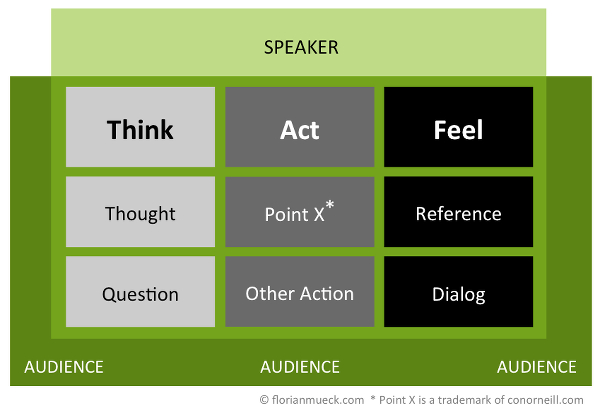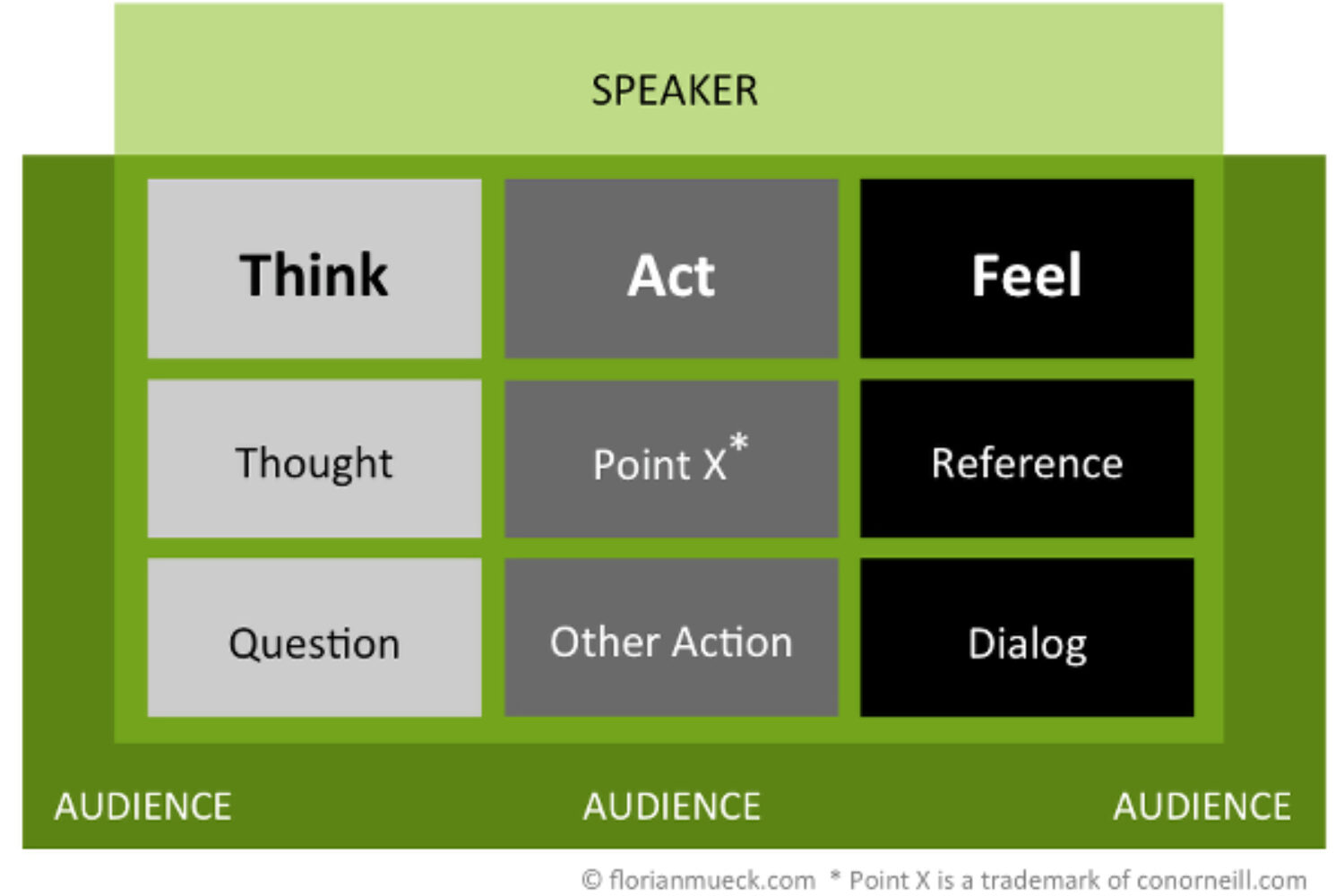
At one point of my public speaking seminars I always ask one simple question.
Who is king – the sales guy or the client?
The client, they respond.
I continue. And who’s the client – the audience or the speaker?
The audience, they respond.
Exactly! Now – who is king – the speaker or the audience?
Your audience is king; your audience is the true protagonist. And do we make them feel like the true protagonists?
We talk about our service, our product, our approach, our strategy, our vision, our business plan, our solution. We, we, we, we, we, … It sounds like a Nintendo Christmas ad.
The key that opens the gate for your audience to feel heard, respected and acknowledged is a key of empathy. That key is called interaction.
Apart from making your audience feel being a part of your speech, interaction also keeps the level of attention in your audience high. You have multiple ways to interact with your audience and make them think, act and feel.
Think
As a speaker you can trigger thoughts in the minds of your audience. But not only that; you can canalize the way they think. You can drag them all onto the same page of thought. On that page you’re fully connected with your audience. I differentiate between making them think and asking questions, which require an instant answer hence thought.
Thought
Entering the brains of your audience – a psychological approach. I refer to it as the Hannibal Lecter effect. The character Lecter has the ability to sense what people think and feel. Lecter uses his ability to manipulate others. I hope you’re not a second Hannibal Lecter, but you too can influence the thoughts of your audience.
For instance, you could start a paragraph of your speech saying, Think about…
Once I gave an inspirational speech at Heureka – an online conference in Berlin. At one point of the speech I said,
Think about the best road trip of your life. Think about those friends in that car on the best road trip of your life. Think about that great music in that car on the best road trip of your life. Think about all the fun and laughter in that car on the best road trip of your life. Weren’t those great vibes?
During the cocktail party after the conference some guy approached me with a smile and yelled at me, Norway!
What?
Our road trip… The Norwegian Fjords – the best time of my life!
You see, on that day, in that room, 548 people relived the best road trips of their lives.
Some speakers ask their audience to close their eyes before they make them enter the re-living room (Check Craig Valentine for more info about the re-living room concept). I think this is quite cliché-ish. People can think with their eyes open. Up to you.
Do not picture this or that is another thought trigger.
My Toastmasters friend Francisco from Brazil gave a speech at a Mallorca conference. At one point he told us, Whatever you do… Whatever you do, do not picture me naked!
Of course, in our minds we all saw this kind, naked Brazilian in front of us. On top, Francisco harvested a great laugh.
You can tell people to think about something or not think about something – they’ll always do!
Then, there are speech moments when you are Hannibal Lecter. You just sense what your audience thinks or feels. When you start a paragraph saying, I know what you feel… – that’s a golden moment of public speaking. More empathy? More connection? Impossible.
One thing you should never do as a speaker is to assume what your audience thinks. Speakers often say, Now you might be guessing… Or, You might be thinking now…
Benny Hill, the English comedian, said that, If you ASSUME, you make an ASS of U and ME.
The solution to the assumption problem has its roots in the second thought trigger – the question.
Question
Did you know that our human brain is incapable of not answering a question?
Have you been to Greece? Whether you’ve been to Greece or not – you see the deep blue Mediterranean Sea and those picturesque white buildings plugged into the mountainous cliff lines.
A question makes any audience think – instantly.
Two reflections. One, always ask direct questions. Speakers love to say, I don’t know who of you’ve been to Greece. I hear this indirect form of asking much more often than the direct question, Have you been to Greece?
I don’t know about you, but a sentence that starts with I don’t know cannot be the most persuasive phrase. If you don’t know it, don’t say it. Plus, indirect questions may let your audience drift away mentally. Only a direct question is instant glue for their thoughts.
Two, avoid open questions. Open questions invite the loud and noisy alpha dogs in your audience to attack. What do you think about the economical situation in Greece? A question like this one and you’re dead. Alpha dogs love to leave scratches on your ethos pillar (Ethos = the speaker’s credibility and authority). They’ll yell something back at you. The moment you enter the discussion you’re lost. Closed questions, which can only be answered by yes or no, are the safe path.
A special form of the closed question is the rhetorical question. Rhetorical questions demand an obvious answer. Don’t we work too much in life? – Yes. Apart from triggering the obvious thought, rhetorical questions are a great way to make your audience confirm your point of view.
And why is the question the solution to the assumption problem? Simple. Any assumption like, We all love shopping, is always wrong. Some people in your audience hate shopping. You better take the risk-free path of asking, Who of you loves shopping?
Act
Rhetoric is the art of persuasion and, as a consequence, moving people to action. In order to move people to action more effectively, you need to make them perform a symbolic act.
Point X
In his 1984 business book classic on persuasion and marketing, Influence: The Psychology of Persuasion, Dr. Robert B. Cialdini comes to the conclusion that people who commit, orally or in writing, to an idea or goal, are more likely to honor that commitment because of establishing that idea or goal as being congruent with their self-image.
This means that a symbolic act performed by your audience increases their level of commitment. Conor Neill, Professor of Persuasive Communication at IESE Business School, calls it Point X.
At a practical communication session of the Global Executive MBA program of IESE I experienced one of the most memorable Point Xs ever. One of the participants wanted to persuade us to reduce the level of salt in our daily diet. Before his speech he put a regular bouillon cube in front of everyone. When closing his speech he made us open the cubes, break them into halves and then eat one half of the bouillon cube. I’ll never forget that horrible taste of pure salt. Now – every time I’m about to use one of those cubes I think back to that speech. Most of the times I avoid using them. What a powerful Point X!
Point X is a specific action, but you can also make your audience randomly act throughout your speech. Based on my experience, audience action is the most powerful retriever of audience attention.
Other Action
Do you know the golden rule of public speaking? There’s no rule. You set the rules. Imagine you have to give a 45-minute talk at a university.
45 minutes is an eternity, especially for a non-professional public speaker! After eight seconds your audience starts to think about their upcoming dinner party, the diapers they still have to buy or that they should’ve gone to the bathroom during the break. After 1.5 minutes they’re completely gone. After seven minutes they last man standing falls asleep, and even the most exciting TED talk doesn’t last longer than 18 minutes – for a good reason. 45 minutes is an eternity!
Once the CTO of an Internet holding company based in Berlin sent me an email asking for advice. He had to give such a 45-minute talk. I told him to include two to three-minute minute breaks after each of the three main content blocks. In those mini breaks his audience could reflect in teams of two on the content they’d just heard. It was a great success. The CTO told me afterwards that audience attention was back to 100% after each break.
As a speaker you have the psychological power to make your audience act. Independent from age, sex or position – once you stand and your audience is seated, you have the psychological power to lead.
You can make them work in teams of two. You can make them clap. You can make them stand up. You can make them pour water into 45 glasses and drink it ritually. You can make them sing. You can make them grab 125 photos of your 2-year-old son that are stuck underneath their chairs. You can make them do crazy stuff.
Make them do crazy stuff! Action retrieves attention like our Golden Retriever Lucas retrieves his colored ball.
Feel
You make your audience think, and you make your audience act. For me, the highest level of engagement on an individual level is when you make them feel.
You can make them feel acknowledged. In my charisma seminars one speech topic is called, How do I motivate my colleagues? The one factor, which is mentioned the most, is public acknowledgment. In terms of motivation, public acknowledgment beats any paycheck. As a speaker you have two ways to benefit from this concept.
Reference
First, you can make references to other speakers or people from the audience.
- Like Thomas said in his talk, …
- Like Maria, I also grew up in a small village…
- I totally agree with what Jeff said before…
- Irene is from Chicago. I’ve never been there, but after talking to Irene I’m definitely going to visit Chicago anytime soon.
- My colleagues Brandon, Nizami and Charlotte know what I mean when I say…
References to others make them feel good. You put them on the spot, and by doing so you acknowledge them in some way or the other. References also show that you listen to others. References are a great indicator of empathy.
Dialogs
While references to others are an indirect form of acknowledging them, one-to-one dialogs are even more direct.
- Thomas, you said in your talk that…
- Maria, I also grew up in a small village…
- Jeff, I totally agree with what you said before…
- Irene, you’re from Chicago. I’ve never been there, but after talking to you I’m definitely going to visit Chicago anytime soon.
- Brandon, Nizami, Charlotte, you know what I mean when I say…
I love one-to-one dialogs. You hardly ever hear them in public speeches. For me, they build the peak of audience connection. Your audience is an entity. When you single out one of them, they all feel involved.
You can make your audience feel acknowledged by making references to people from the audience and talking to individuals. You can make them eat bouillon cubes and act in many other ways. You can make them think by asking closed questions or using thought triggering phrases.
Start to interact with your audience in your next speech or presentation. They will love you much more as a speaker because finally someone has understood who’s the real protagonist. Finally someone knows who is king. It’s not you.

